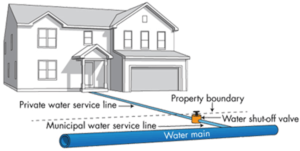What is a Water Service and Why is it Important?
Water mains are the pipes delivering the water supply throughout most communities. This network of pipes is usually installed below the community’s streets. A water service line is what connects your building with the water main. From the water main to the building, a water service has multiple components. Right next to the water main the service has a gooseneck. The gooseneck is an S-shaped section of pipe that provides flexibility for movement of the service or water main without breaking the connection. The service runs from the gooseneck to the curb stop. The curb stop is the valve that is located near the property line. You will often see the cap of the curb stop in the grass behind the sidewalk or in the boulevard. The curb stop is the point of transition from the public owned portion of your water service to the private owned portion of the water service. From the curb stop, the water service extends through your yard into your home underground.
In part of the early 20th century, lead pipes were used to connect buildings to water mains under the street surface. When the water industry standard moved away from lead services galvanized iron and copper piping became the norm. Galvanization is the process of applying a protective zinc coating to steel or iron, to prevent rusting. However, galvanized iron is rigid. In some cases a lead gooseneck (approx. 2 ft of pipe) was used to connect the water main to customers’ service lines. The lead material could be easily bent and allowed for a flexible connection between the rigid pipes.
While the city can replace lead goosenecks next to the water main is it important to also replace the full water service to the home if the water service material is galvanize iron. Household galvanized pipes are old, corroded pipes that were installed in many homes before the 1980s. These pipes can release lead in water if the property has, or previously had, a lead service pipe. Galvanized pipes are made with a protective layer of zinc. However, the zinc layer erodes over time and results in corrosion. When lead is released from a lead service pipe and passes through galvanized plumbing, lead can accumulate on the inside, corroded walls of this plumbing. Lead release from galvanized pipes can vary from home to home and can continue to occur even after a lead service pipe is replaced.

